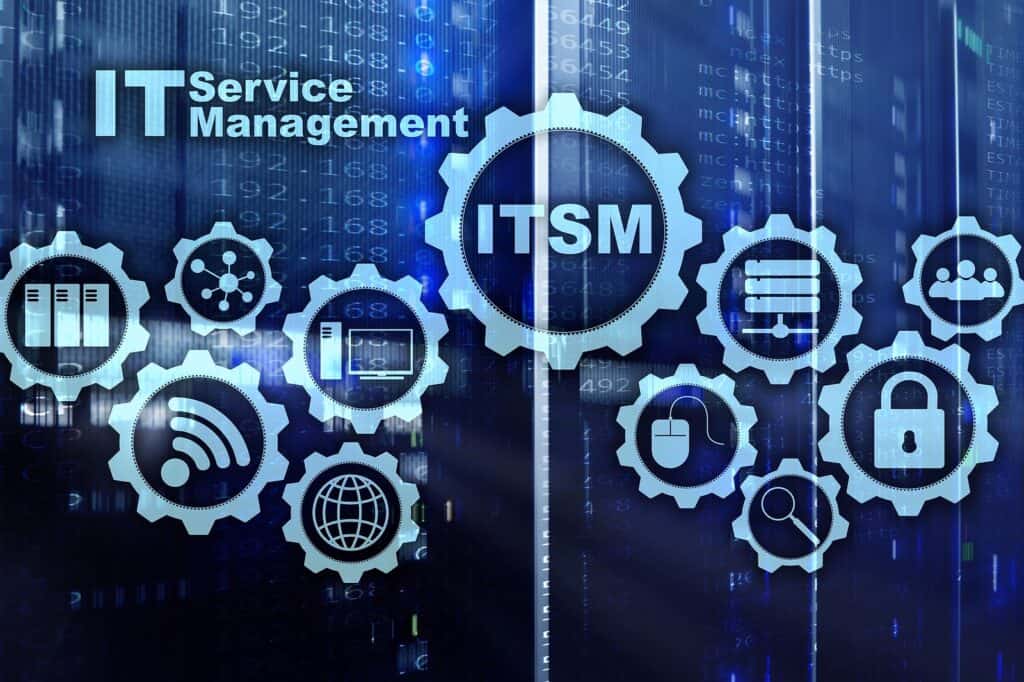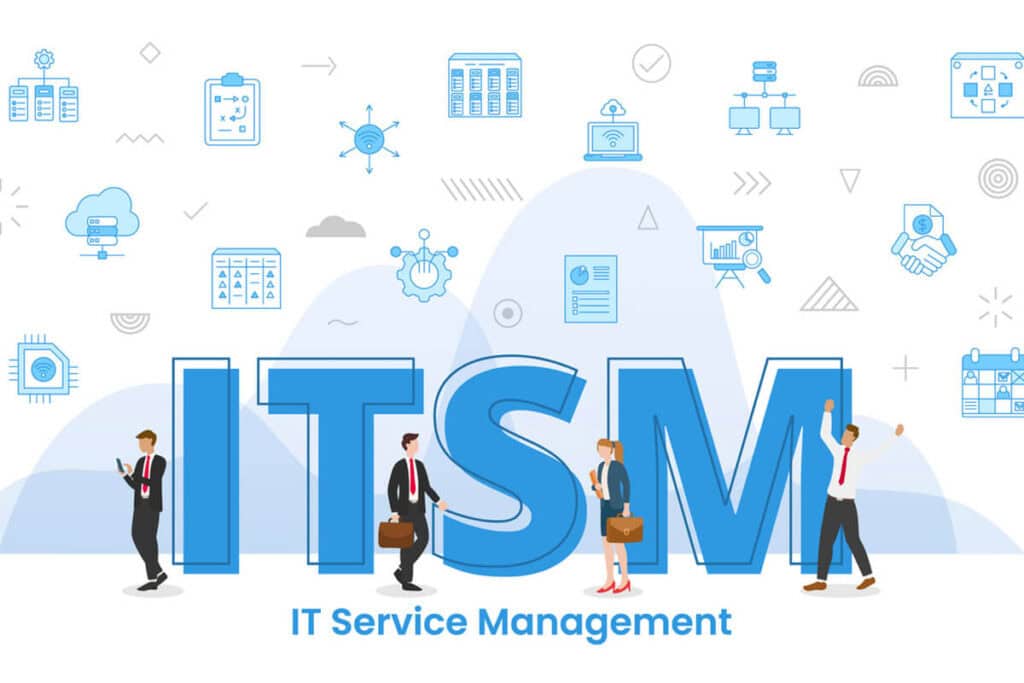Key Highlights
- ITSM ensures IT services align seamlessly with business goals for optimal efficiency and productivity.
- Discover the interplay between ITSM, ITIL, and DevOps, understanding their unique roles in IT management.
- Embracing agility is paramount; we’ll explore how ITSM is adapting to the dynamic nature of modern business.
- Navigate the implementation process with a step-by-step guide, from assessing your current IT landscape to selecting the right tools.
- Measuring success is key; understand the vital metrics and KPIs that demonstrate the effectiveness of your ITSM strategy.
Table of Contents
ToggleIntroduction
Businesses must use technology to meet their goals. IT service management (ITSM) is an important area that helps companies connect their IT services to business goals. It also helps make operations easier and improve customer experiences. This beginner’s guide will give a simple overview of ITSM and explain why it is important for digital transformation.

Understanding What ITSM is in Today’s Digital World
Imagine a world where technology helps your business run smoothly. It empowers workers and impresses customers. This is what good IT service management can do for you. Just fixing IT problems is not enough anymore. You need to plan ahead and take action.
IT service management (ITSM) offers a way to create this change. It moves the focus from just solving issues to delivering services in a smart way. By using clear processes and best practices, companies can make sure their IT systems always help meet their business goals.
The Evolution of IT Service Management
The way we manage IT services has changed a lot. This change comes from our growing use of technology and how complicated IT systems have become. At first, IT teams mainly focused on keeping hardware and software running. But as companies relied more on technology, they needed a better way to handle IT services.
This need led to IT service management (ITSM). ITSM helps make the process smoother and ensures that IT services are provided in a reliable and efficient manner. A big part of ITSM is continual service improvement. This means we should always look for ways to check and improve IT processes. This helps IT adapt and meet the changing needs of businesses today.
ITSM’s Role in Modern Businesses
In today’s connected world, good service delivery is very important for a business to succeed. IT Service Management (ITSM) is key in bettering IT operations. It helps meet business needs and makes customers happy. When a strong ITSM framework is in place, companies can keep service quality high, cut down on downtime, and boost customer satisfaction.
Another important part of ITSM is making sure IT aligns with business goals. When IT works well with other departments, it helps technology spending bring real value to the business. When businesses see IT services as important resources, they help drive growth, spark new ideas, and give a competitive edge.
ITSM also helps businesses embrace digital transformation. It provides a clear way to manage technology changes. This allows companies to quickly adapt to new trends, use new tools easily, and drive innovation in their daily operations.

ITSM, ITIL, and DevOps: Navigating the Frameworks
As you explore IT service management, it’s important to know the different frameworks that help in using it. ITSM, ITIL, and DevOps are often thought of as the same, but they have different jobs.
ITSM can be seen as the main idea that focuses on linking IT with business goals. Inside this main idea, ITIL offers a complete list of best practices. DevOps acts like a cultural change that helps connect development and operations.
Breaking Down ITSM for Beginners
ITSM, or IT Service Management, is all about how to manage and deliver IT services to users. These services include technical support and managing IT infrastructure. The main aim is to make sure IT helps business operations in a good way.
ITSM focuses on using best practices. These are tested ways to improve IT processes. Best practices include things like incident management, change management, and problem management. They give IT teams a guide to follow.
When organizations stick to these practices, they can make IT processes more efficient. This helps to lower mistakes and boost the efficiency of IT service delivery.
How ITIL Complements ITSM Practices
ITIL stands for Information Technology Infrastructure Library. It is a well-known framework that offers a set of best practices for IT service management. ITIL helps manage IT services from their start to their end. This includes service strategy, design, transition, and operation.
ITIL processes help match IT services with business needs. This way, IT can add more value to the organization. The processes include important areas such as incident management, change management, and problem management. They give IT teams a clear guide to follow.
By using ITIL, organizations can enjoy a common way to manage IT services. This leads to better efficiency, lower costs, and happier customers.
The Intersection of DevOps and ITSM
DevOps combines “development” and “operations.” It shows a shift in IT that focuses on teamwork and communication between software development and IT operations. The goal of DevOps is to reduce the divide between these teams. This means a better way to deliver software.
When teams work together, they can speed up the software development process. This allows groups to release updates and new features more often and reliably. With development and operations in sync, businesses can quickly adapt to changing market demands and customer needs.
IT Service Management (ITSM) looks at managing all IT services. On the other hand, DevOps focuses on the software development and deployment parts of that process. Together, both approaches support each other. DevOps makes ITSM more agile and quicker.

The Shift to Agile ITSM
As companies deal with fast-changing markets, being flexible and adaptable is very important. Because of this, IT service management is changing a lot. It is now using agile ideas to respond better to the changing needs of businesses.
This move from strict, heavy processes to more flexible, customer-focused methods is key for companies to stay competitive in today’s digital world.
From Rigid Processes to Flexible Solutions
Traditional ITSM models used strict processes and a lot of documentation. This sometimes made it hard to be quick and responsive. Agile ITSM focuses on being flexible and adaptable. This helps IT teams react faster to new requirements and provide solutions more quickly.
The move toward agile methods is changing how IT departments manage projects. Instead of taking a long time for projects, agile breaks them into smaller parts. This way, teams can improve constantly and adapt better to changing needs.
This method encourages a culture of ongoing learning and improvement in IT teams. This helps them stay ready and responsive to the changing demands of the business.
Emphasizing Team-Centric Approaches
Agile ITSM focuses on teamwork. It breaks down barriers between IT professionals and helps different departments cooperate better. This fits with a larger idea of improving communication and teamwork in organizations.
When IT support teams work well together, they can share their knowledge and skills. This helps them find new solutions, solve problems quickly, and provide a better customer experience. This teamwork also includes working with end users.
Agile ITSM promotes open talks and feedback. This ensures IT services meet the users’ needs. By involving everyone in the IT service process, companies can create a sense of shared responsibility and teamwork. This leads to happier users.

A Beginner’s Guide to Implementing ITSM
Implementing ITSM may seem hard, but it doesn’t have to be. If you follow a clear plan and focus on what your organization needs, you can build a strong ITSM framework. This will improve efficiency and help IT meet your business objectives.
Here are steps to guide you in putting ITSM in place. Start with looking at your current state. Then, choose the right tools and encourage a culture of continuous improvement.
Essential Tools and Resources Needed
Before you start your ITSM journey, you need to give your team the right tools. Getting good ITSM tools is important. They help you automate workflows, simplify processes, and boost productivity.
One key part of your ITSM tools is a strong service desk solution. This software helps manage all IT requests, incidents, and problems. When choosing a service desk solution, think about how easy it is to use, how well it can grow with you, its automation features, and how it works with your current systems.
Also, managing resources is very important for a successful ITSM setup. Make sure you have enough staff, money, and training to support using new processes and tools.
Step 1: Assessing Your Current IT Processes
- Start by looking closely at how your organization currently delivers IT services and runs operations. You should find any issues, spots to improve, and chances to connect IT processes with business goals better.
- Think about using surveys, interviews, and workshops to get feedback from IT staff and end users. This will help you understand where your organization stands now. It will set a basis to track your progress and make sure your IT service management implementation focuses on the most important areas.
- Also, look at best practices in the industry and compare your IT performance to similar organizations. This can give you good ideas on how to improve your IT operations.
Step 2: Planning Your ITSM Strategy
Once you understand your current IT setup, start planning how to implement IT Service Management (ITSM). First, define your business goals clearly. Next, identify the key performance indicators (KPIs) that will help you measure success. Finally, create a roadmap that outlines how to reach your goals.
Your ITSM strategy should match your organization’s business goals. This way, your IT projects will support the larger objectives. IT management should actively share the benefits of ITSM with everyone involved and get their support.
Focus on initiatives that will make a big difference and are doable. This will help you use your resources wisely and show the benefits of ITSM from the start.
Step 3: Selecting the Right ITSM Tools
Choosing the right ITSM software is very important for a successful setup. There are many options available. You need to pick one that fits your organization’s needs, budget, and tech skills.
Here are some key features to think about:
- Incident management
- Problem management
- Change management
- Service requests management
- A self-service portal
- Knowledge management
- Reporting and analytics
Integration is also very important. It helps your ITSM tool share data easily with other business software.
Make sure the software can grow with your organization and adapt to future IT needs. Having a good configuration management database (CMDB) is necessary too. It helps keep a central record of all your IT assets and configurations.
Step 4: Training Your Team on ITSM Best Practices
Implementing new tools and processes is just part of the challenge. It’s also important to give your IT professionals the knowledge and skills they need to use ITSM best practices.
When you invest in thorough training programs, your team will learn the basics of ITSM. They will know how to use the tools well and apply best practices every day. Training should cover everything about ITSM, including problem management, change management, and service level agreements.
Think about providing a mix of online classes, in-person workshops, and on-the-job training. This way, you can meet different learning styles and preferences. Holding regular training sessions and promoting sharing of knowledge will help create a culture of continuous learning.
Step 5: Executing and Managing Your ITSM Plan
It’s time to put your ITSM plan into action after laying the groundwork. Start by carrying out the implementation in stages. Begin with pilot projects to test new tools and processes in a safe setting. Then, slowly introduce ITSM throughout the organization. This will help make sure the changes go smoothly and allows you to tackle any problems that come up.
Good management is vital during this process. Set up clear ways to communicate and keep track of how you are doing by checking progress with key performance indicators (KPIs). Be ready to adjust your plans based on feedback and any new needs. Regular communication and getting help from stakeholders are important. They help gain support and reduce pushback against changes.
Make sure to check and improve your ITSM processes often. This is key to continuous improvement. Encourage a culture of feedback. Ask your team and end users for ideas on how to improve IT services and increase overall efficiency.

Leveraging Top ITSM Tools for Your Business
The market has many ITSM software solutions. Each one has its own good points and bad points. It is important to choose the tool that fits your business needs. This choice helps you get the most value from your ITSM investment.
Think about different things like how easy it is to use, if it can grow with your needs, how well it automates tasks, how it connects with other tools, and what it will cost you overall. You need to find a balance between the features, what it can do, and your budget.
Criteria for Choosing the Best ITSM Tools
When looking at ITSM tools, you should think about a few important points. First, make sure the tool fits your organization’s specific needs. If your main focus is incident management, choose tools that have strong ticketing systems and automation features.
Next, consider how well the tool can grow and change. Can it support your organization’s growth and adjust to future IT needs? It is also very important that the tool works well with your existing IT systems. This means your data should flow easily between different applications without too much manual work.
Having strong asset management features is key too. This helps you keep a good record of your IT assets, follow their lifecycle, and use them effectively. Look for tools that provide a centralized configuration management database (CMDB) to make tracking and managing assets easier.
Top Recommendations for ITSM Software
|
ITSM Software |
Key Features |
|
ServiceNow |
Comprehensive ITSM suite with robust automation capabilities and a wide range of integrations. |
|
Jira Service Management |
Agile-focused ITSM solution known for its user-friendly interface and strong project management features. |
|
Freshservice |
Cloud-based ITSM platform offering an intuitive user experience and affordable pricing plans. |
|
BMC Helix ITSM |
AI-powered ITSM platform designed for enterprise-level organizations with complex IT environments. |
|
Ivanti Service Manager |
Comprehensive IT service and asset management solution with strong automation and self-service capabilities. |
These platforms are recognized leaders in the ITSM market, offering a wide range of features, flexible pricing plans, and robust support services. When making your final decision, consider conducting product demos, reviewing customer testimonials, and carefully evaluating the vendor’s track record.
Ultimately, the best ITSM software empowers your IT team to deliver exceptional service experiences, improve service efficiency, and align IT operations with your organization’s strategic objectives.

The Importance of Continuous Learning in ITSM
IT service management is not a final goal; it is a continuous journey of learning and improvement. Technology is changing quickly, so IT professionals must keep up with new trends and best practices.
When organizations promote a culture of constant learning, they help their IT service management stay effective and relevant. This alignment is crucial as the digital world keeps evolving.
Training Organizations and Certifications
Investing in training and certifications is very important for creating a skilled ITSM team. Many organizations offer detailed ITSM training programs. These programs include topics like ITIL foundation and ITIL practitioner, among others. Professional ITSM certifications show a dedication to doing well and improve job chances for IT professionals.
Getting certifications proves your skills and knowledge. This gives employers trust in their team’s abilities. Adding training and certifications to your ITSM strategy helps create a culture of continual service improvement. Motivate your team to seek out chances for ongoing professional growth to keep up with the best practices in ITSM.
Regular training and sharing knowledge help your IT team stay updated on the newest trends, technologies, and best practices in the industry. Committing to continuous learning helps your organization welcome innovation and adjust to changes successfully.
Building a Culture of Continuous Improvement
Continuous improvement should be a key part of your organization’s culture. It goes beyond just making processes better. You should encourage every team member to help find ways to improve and actively look for solutions to enhance IT services.
Make it a habit to ask for feedback from both IT staff and end users. This feedback is important for finding out where you can simplify processes, improve services, and create better user experiences. You can use tools like surveys, suggestion boxes, and regular meetings to collect insights from different people.
By building a culture of continuous improvement, you make a space where new ideas and innovation can grow. This will help keep customer satisfaction high and improve IT services to meet changing organizational needs.
Measuring Success in ITSM Initiatives
Implementing ITSM is just the first step. To make it work well, you need to keep watching and measuring its success. Setting up key performance indicators (KPIs) helps you see how you are doing. It can show areas that need improvement and prove the value of your ITSM strategy.
By looking at data often and getting feedback from people involved, organizations can improve their ITSM processes. This ensures that they keep up with changing business objectives.
Key Metrics and KPIs for ITSM Performance
Several important metrics and KPIs help you understand how well your ITSM efforts are working. The first-call resolution rate shows the percentage of issues solved during the first contact with the service desk. This highlights how effective your support team is and how useful your knowledge base is.
Mean time to resolve (MTTR) looks at the average time it takes to fix issues. This tells you how efficient your problem management processes are. Customer satisfaction surveys measure what users think about IT services. These surveys provide helpful feedback to support the numbers you see in other metrics.
By keeping an eye on these and other important KPIs, IT leaders can find problems, see how improvements work, and show the value of ITSM to the organization.
Using Feedback to Refine ITSM Processes
Feedback is very important for improving IT service management (ITSM) and making things better over time. It’s a good idea to regularly ask for feedback from both IT workers and end users. This helps you get different views on how well your IT services are working. You should create clear ways to collect feedback, like using surveys, suggestion boxes, and online forums.
Make sure to analyze the feedback you get. Look for common themes and focus on the areas where making changes will have the biggest effect. This customer-focused approach makes sure your ITSM strategy meets what users need and expect.
You should also set up a structured change management process. This helps to make sure any changes to ITSM are smooth and effective. Clearly tell everyone involved about the changes. Provide enough training, and closely watch how these changes affect the users. This way, you can make more adjustments if needed.

Conclusion
In today’s world, IT Service Management (ITSM) is very important. It helps improve how companies work and makes sure that IT services match their goals. It is essential for modern businesses to understand how ITSM has changed over time. They should also know how it connects with frameworks like ITIL and DevOps, as well as the move towards agile methods.
To put ITSM into action, businesses need to check their current processes. They also need to plan ahead and train their teams. Continuous learning and being able to adapt are key ideas for successful ITSM projects. By using the best ITSM tools and creating a culture focused on improvement, companies can enhance their performance. They will also be able to keep up with changes in the IT world. Staying informed, accepting change, and driving innovation through ITSM is crucial for success.
Frequently Asked Questions
What is the difference between ITSM and ITIL?
IT Service Management (ITSM) is how we manage IT services. On the other hand, the Information Technology Infrastructure Library (ITIL) is a set of specific guidelines. It shows best practices in ITSM. To sum it up, ITSM is the overall idea, and ITIL gives the steps to put that idea into action.
How can small businesses benefit from ITSM?
ITSM can help small businesses make their IT support better and improve how they manage services. It helps keep technology in line with their business goals, even when resources are limited. ITSM makes sure the IT service delivery is consistent. This is very important for small businesses that have increasing IT needs.
Are there any prerequisites for implementing ITSM?
To start with ITSM implementation, you need to have a basic understanding of your IT infrastructure and how it works. It’s also important to check your current IT maturity level. This will help you see what you can improve before you’re fully ready.
Can ITSM be applied to non-IT sectors?
Absolutely. The main ideas of service management are process optimization, customer focus, and continuous improvement. These ideas are important in many areas. IT service management can be changed to make processes smoother and improve service delivery in different industries.
How often should ITSM strategies be reviewed?
Regular reviews are important to stay in line with changing business needs. It is usually suggested to look at and update ITSM strategies at least once a year. In fast-moving environments, do this more often. This helps include continuous improvement and best practices.
The Future of ITSM
The future of IT service management (ITSM) will be influenced by new technologies. This includes artificial intelligence, machine learning, and automation. These new tools will help teams manage services better. They will allow for more proactive service management. They will also offer predictive analytics and improve customer experiences.
Anticipating Changes in ITSM Trends
Staying on top of ITSM trends means you need to keep learning, engage with the industry, and manage change actively. Organizations should use flexible strategies. This will help them meet changing customer needs and make the most of new technology.
ITSM’s Role in the Growing AI Landscape
Artificial intelligence will have a big impact on IT service management (ITSM). It will bring better automation, useful data analysis, and smart self-service options. Using AI in ITSM tasks will help improve efficiency and make customers happier.
Preparing for the Next Wave of IT Innovations
Embrace new ideas and be quick to adjust to get ready for future changes in IT. Keep learning, invest in new technologies, and use flexible service management methods. These steps are important to stay ahead.





